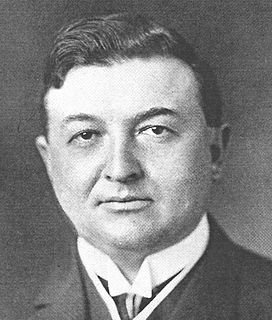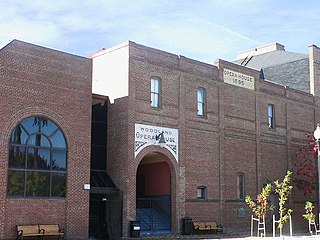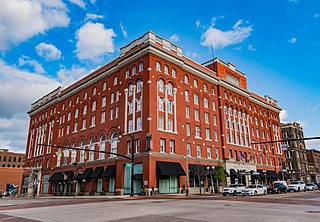
Loew's Grand Theater, originally DeGive's Grand Opera House, was a movie theater at the corner of Peachtree and Forsyth Streets in downtown Atlanta, Georgia, in the United States. It was most famous as the site of the 1939 premiere of Gone with the Wind, which was attended by the stars of the film, except for the African Americans who appeared in it, who were also excluded from the souvenir program.

The Grand Opera House is an opera house located at the corner of 8th and Iowa Streets in Dubuque, Iowa that was built in 1890. It was listed on the National Register of Historic Places in 2002.

Claude and Starck was an architectural firm in Madison, Wisconsin, at the turn of the twentieth century. The firm was a partnership of Louis W. Claude (1868-1951) and Edward F. Starck (1868-1947). Established in 1896, the firm dissolved in 1928. The firm designed over 175 buildings in Madison.

John Adolph Emil Eberson was a Ukrainian American architect best known for the development and promotion of movie palace designs in the atmospheric theatre style. He designed over 500 theatres in his lifetime, earning the nickname "Opera House John". His most notable surviving theatres in the United States include the Tampa Theatre (1926), Palace Theatre (1928), Majestic Theatre (1929), Akron Civic Theatre (1929) and Paramount Theatre (1929). Remaining international examples in the atmospheric style include both the Capitol Theatre (1928) and State Theatre (1929) in Sydney, Australia, The Forum and Le Grand Rex.

The Grand Opera House, also known as The Grand or Masonic Hall and Grand Theater, is a 1,208-seat theater for the performing arts in Wilmington, Delaware, United States. The four-story building was built in 1871 by the Delaware Grand Lodge of Masons to serve as a Masonic Temple and auditorium. The construction cost was $100,000. It was designed in Second Empire style by Baltimore architect Thomas Dixon and incorporates symbolism from Freemasonry into the cast-iron facade. Its central pediment contains an Eye of Providence.

The Woodland Opera House, listed on the National Register of Historic Places and a California Historical Landmark, is one of four fully functioning 19th century opera houses in California. It is a contributing property to the Downtown Historic District of Woodland, California.

This is a list of the National Register of Historic Places listings in Northampton County, Pennsylvania.

The Great Southern Hotel & Theatre is an historic hotel and theater building in Downtown Columbus, Ohio. The building currently operates as the Westin Great Southern Columbus and the Southern Theatre.

Thompson's Opera House, also known as Brown's Hall, Brown's Opera House or the Gem Theater, is a small theater building in Pioche, Nevada. The Opera House is a wood-frame building built in 1873, attached roughly to the adjoining brick Gem Theater, a 1937 masonry cinema.

The Majestic Theatre is a performing arts theater in the City Center District of Downtown Dallas. It is the last remnant of Theater Row, the city's historic entertainment center on Elm Street, and is a contributing property in the Harwood Street Historic District. The structure is a Dallas Landmark and is listed on the National Register of Historic Places.

Smith Opera House, also known as the Geneva Theater, the Smith, and Smith's Opera House, is a historic theater building located at Geneva in Ontario County, New York. It was constructed in 1894 and is a 3+1⁄2-story, detached brick-and-stone building. It was built by one of Geneva's most respected citizens, William Smith. It was renovated in 1931 as a movie theater by architect Victor Rigaumount in a unique combination of Art Deco and Baroque motifs. At one time, it was part of the Schine Theater Chain and was substantially redecorated and redesigned under their ownership. In the late 1960s the theater changed to the ownership of Panther Enterprises and was renamed simply The Geneva Theater. The Geneva Theatre was renamed Smith Opera House in 1983.

Casa Paoli is a historic house and biographical museum in barrio Cuarto, Ponce, Puerto Rico, in the Ponce Historic Zone. The house is significant as the birthplace of Antonio Paoli (1871–1946), a tenor who was the "first Puerto Rican to reach international recognition in the performing arts" and "one of the most outstanding opera singers of all times". The house was the childhood home of the artist and he was introduced to art and opera at this house during his formative years. In 1987, the house was turned into a museum to honor the career of Antonio Paoli. The building was listed on the U.S. National Register of Historic Places in 2009.

The Texas Technological College Historic District is a historic district listed on the National Register of Historic Places on the campus of Texas Tech University in Lubbock, Texas. The 110-acre (0.45 km2) district is made up of 27 contributing properties, four non-contributing properties, one contributing structure, one contributing object, and one contributing site.

The Pretzinger name belongs to a family of architects and engineers in Dayton, Ohio. Albert Pretzinger started the family's architectural legacy.

The Downtown Evanston Historic District in Evanston, Wyoming includes about sixty buildings in a compact downtown commercial district.
Oscar Cobb was an American architect of theaters and more. Several of his works are listed on the U.S. National Register of Historic Places.

The Baker Building, also known as Baker's Opera House, in Dover, Morris County, New Jersey, United States, is a historic theater built of brick in the mid-1880s. Built in the Eclectic style, it has three stories plus a tower. On the north side facing Blackwell Street, there are recessed brick panels, granite lintels and window sills, and a granite panel reading "Baker Building." A Mail Pouch Tobacco sign covers the south side of the building.

The Harrington-Smith Block, formerly known as the Strand Theater and the Manchester Opera House, is a historic commercial building at 18-25 Hanover Street in the heart of Manchester, New Hampshire. Built in 1881 to a design by John T. Fanning for two prominent local developers, the building is an expansive rendition of Queen Anne styling in brick and stone. It housed the city's premier performance venue for many years, and was an early home of the influential Manchester Union Leader, the state's major daily newspaper. The building was listed on the National Register of Historic Places in 1987.

Robert W. Hill was an American architect from Waterbury, Connecticut. He was one of Connecticut's most important 19th century architects.

The New Britain Opera House, also known as the Palace Theater, was a performance venue and movie house on Main Street in downtown New Britain, Connecticut. Built in 1880, it was a prominent local example of Renaissance Revival architecture, serving as an entertainment venue for about a century. It was listed on the National Register of Historic Places in 1977. It has since been demolished as part of local urban renewal.





















